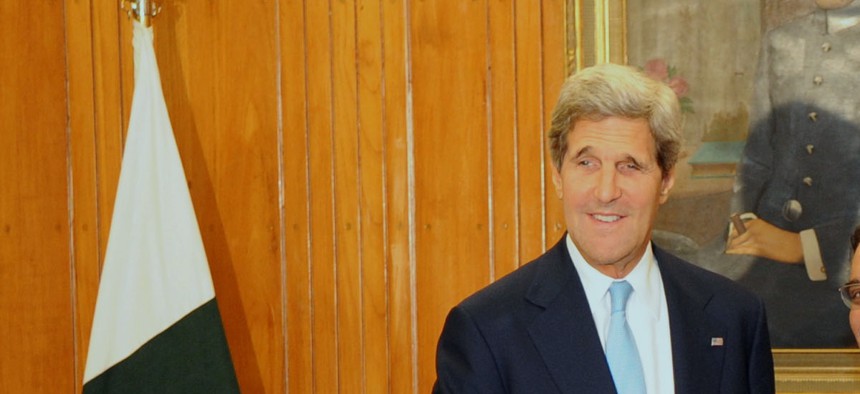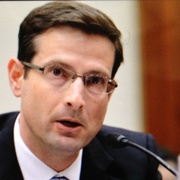
Secretary of State John Kerry meeting with Pakistan's President Asif Zardari State Department
A Big New Idea for U.S.-Pakistan Relations
After a cooling off period, the Obama administration put Pakistan back on the agenda last week promising new talks. It would help if the administration came prepared with something new to discuss. By Daniel Markey
Late last week, with all of Washington’s attention focused on Israel-Palestine diplomacy, Secretary of State John Kerry quietly sneaked out the back door and flew off to tackle another thorny challenge: Pakistan. While in Islamabad, Kerry announced that the United States-Pakistan strategic dialogue would be resumed in order to foster "deeper, broader and more comprehensive partnership." These fine words will need a lot of hard work to back them up. It would help if President Obama’s administration also came to the table with a big new idea to re-energize its difficult relationship with Islamabad.
Relations between the two sides hit rock bottom in 2011 and 2012 and have barely leveled-off since then. Policymakers on both sides now say they appreciate the need for better cooperation and are looking for a way to turn the page. Such a change would be welcome, since the U.S. has important stakes in Pakistan that will persist for decades to come. Nuclear-armed and likely to be the fifth-most populous state in the world by mid-century, Pakistan’s trajectory will affect more than just Afghanistan and the battle against Islamist extremism, if only because it shares borders with the two rising giants of Asia: China and India. Pakistan is a long-term challenge from which the U.S. cannot shy away.
A “turning of the page” with Pakistan would also be timely, since 2013 is a year of leadership transition in Islamabad, starting with the May election of Prime Minister Nawaz Sharif and continuing this fall with the appointment of a new army chief. They will sit across the negotiating table from a strikingly new cast of U.S. diplomats and national security officials as well.
But change will not come easily. The chief obstacle to comprehensive partnership is that many of the issues that have tormented U.S.-Pakistan relations over the past decade remain unresolved. As Pakistan’s recently-leaked draft Abbottabad Commission report makes clear, Pakistan’s security agencies -- both military and civilian -- have routinely demonstrated such incompetence and negligence that Washington is correct not to see them as dependable counterterror partners. Moreover, there is so far little reason to expect that the new Pakistani government will tackle its broader problem of violent extremism (including terrorist groups that operate against India, like Lashkar-e-Taiba) with greater vigor than its predecessor.
Pakistan’s frustrating lack of will and capacity has left the U.S. with few options other than to continue its unilateral counterterror campaign, at least for the time being. That campaign includes flying armed drones over Pakistan’s tribal areas even though Pakistan’s parliament has condemned the practice as a violation of national sovereignty. And if al Qaeda chief Ayman al-Zawahiri is discovered in one of Pakistan’s cities tomorrow, another Abbottabad-style raid would be easy to imagine even though it would send relations between Washington and Islamabad over yet another cliff.
The continuing war in Afghanistan also keeps old issues on the table. Pakistan says it supports the goal of an Afghan-brokered process of reconciliation with the Taliban insurgency. Yet that process is moving slowly and only in fits and starts. Worse, few believe that Washington and Islamabad actually see eye-to-eye with respect to what a post-NATO Afghanistan should look like.
Then there is the question of what a reinvigorated strategic dialogue with Pakistan should actually look like. If it remains mired in the contentious issues of the recent past, we can only expect that it will bear similarly sour fruit. A new animating principle could help to inject energy into the process that will otherwise meet skepticism and exhaustion in the Washington bureaucracy (and likely in Islamabad as well).
One tempting way to re-frame U.S.-Pakistani relations would be to go back to the future. Before “Af-Pak” came “Indo-Pak.” There are still good reasons to believe that the geostrategic relationship between Islamabad and New Delhi will play a decisive role in Pakistan’s future, especially when it comes to issues of top concern to Washington, such as Pakistan’s growing nuclear arsenal.
Given the extent to which the Obama administration has trumpeted its plans to support India’s rise to great power status, it would be natural if U.S. officials increasingly view the future of relations with Pakistan in that context. Many Pakistanis would also welcome renewed American interest in the Indo-Pakistani dynamic, especially if Washington lends its weight promoting a normalized relationship between Islamabad and New Delhi.
The problem with such an approach is that India would bridle at any return to its “hyphenation” with Pakistan in American strategic thought. Not only does India resent being paired with its smaller neighbor, but it fears that U.S. officials will fall into an old pattern of equating the two and pressuring India into granting concessions to its smaller neighbor with the hope of assuaging Pakistan’s sense of insecurity.
A more ambitious and forward-looking way to frame Washington’s agenda with Islamabad would be to consider it within the context of Pakistan’s role in the broader U.S. “rebalancing” to the Asia-Pacific region. Thus far, the rebalancing has had mainly to do with East Asia, although as Vice President Biden recently observed before his travel to New Delhi, India is very much a part of the plan to devote considerably greater attention (and some new resources) to the U.S. presence throughout the broader Indo-Pacific region.
Pakistan, however, has been left out of the rebalancing mix, even though its close links with China and longstanding hostility toward India tie it inextricably to the rest of Asia. And while many Pakistanis would be leery of any rebalancing that boils down to “contain China, support India,” other aspects of the strategy, especially Washington’s emphasis on regional economic integration, would surely receive a warm welcome in Islamabad. Tying Pakistan’s leaky ship of state to the vibrant economies of East Asia would do more to secure its rise than any U.S. or international aid programming could accomplish.
The first step to drawing Pakistan into the broader rebalancing effort would be to include a focused discussion of the issue in the next round of strategic partnership talks, ideally by including senior U.S. officials who manage the East Asia portfolio (just as former U.S. Assistant Secretary for the Bureau of East Asian and Pacific Affairs, State Kurt Campbell made a point engaging in regular talks with his Indian counterparts). Beyond that, Washington would want to begin tying together two of its regional integration projects -- the “New Silk Road” and the “Indo-Pacific Economic Corridor” -- through Pakistan, perhaps by redirecting development assistance toward roads, ports and pipelines (especially the Turkmenistan-Afghanistan-Pakistan-India, or TAPI, pipeline).
Factoring Pakistan into the rebalancing will not quickly solve the lingering challenges of terrorism or Afghanistan. But it would place those issues in a broader, long-term context -- one that is consistent with the Obama administration’s foreign policy priorities and sets a constructive new tone for bilateral dialogue.
Daniel Markey is a senior fellow for India, Pakistan and South Asia at the Council on Foreign Relations, and author of No Exit from Pakistan (forthcoming).
